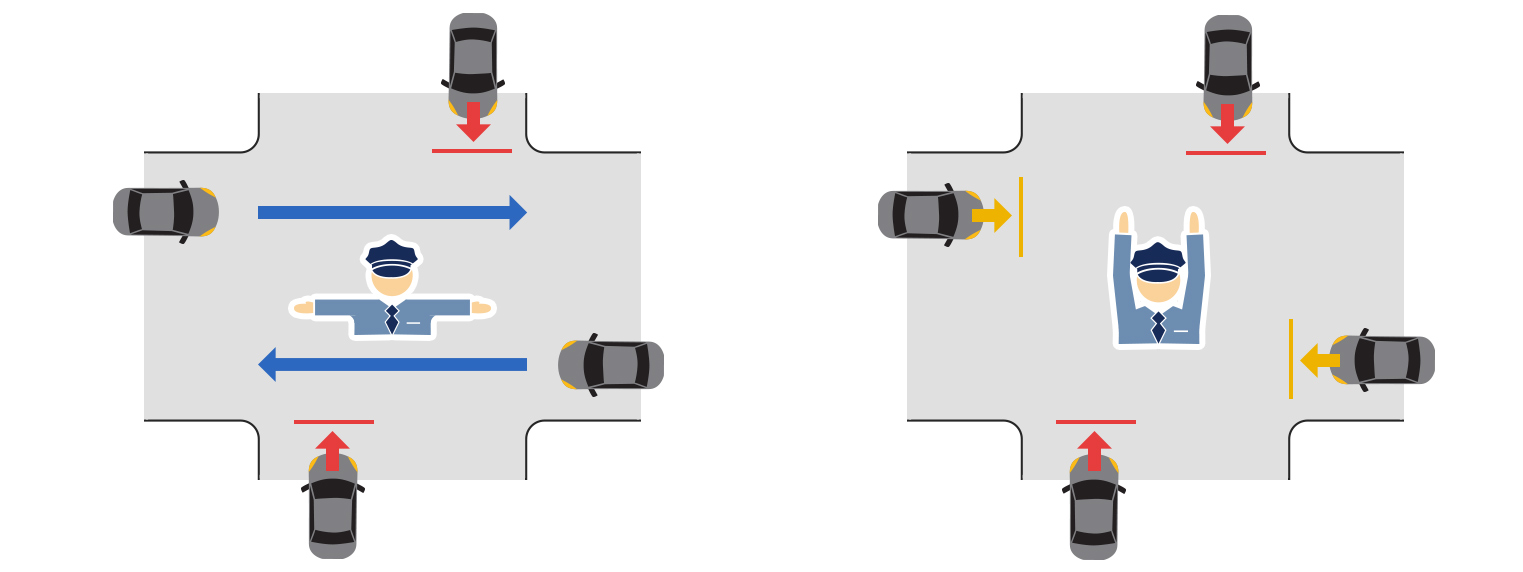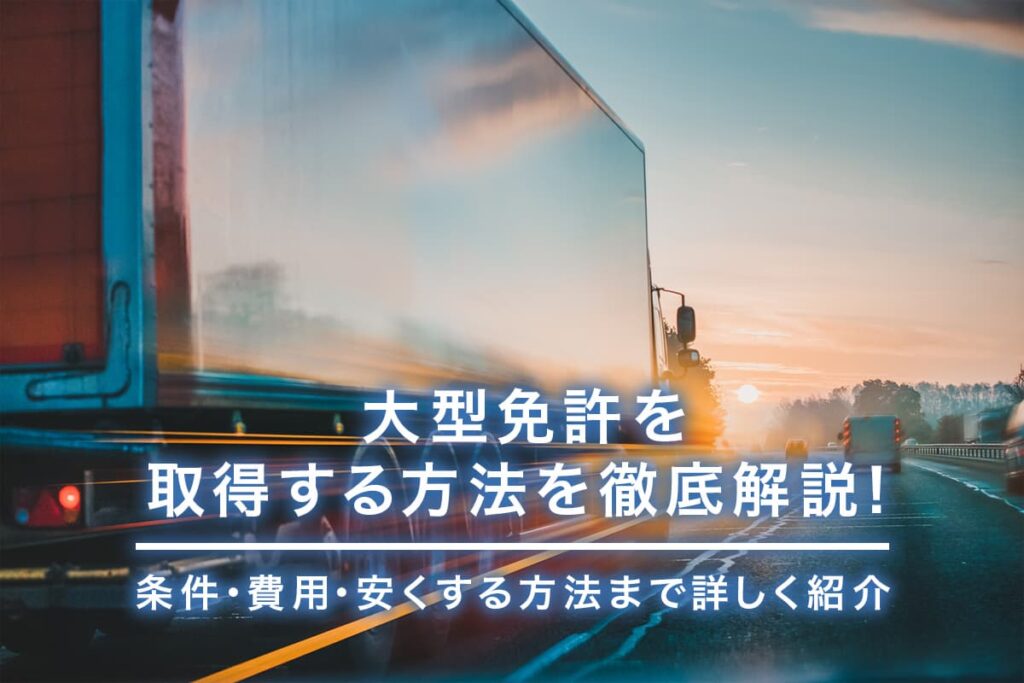学科テストの直前となり、何日も対策をして勉強をする時間はないが、最低限押さえるべきポイントや確実にスコアアップができる方法がないかお探しではないでしょうか?
まずはこの問題を解いてみて下さい。
1. 車を運転する時は、どんな時でも必ずシートベルトを着用しなければならない。
2. 運転中、歩行者のそばを通るときには、必ず一時停止をしなければならない。
3. 車を運転中、急ブレーキは絶対にしてはいけない。
【答え】
① ×(後退時や負傷病気等をのぞく)
② ×(徐行もしくは一時停止)
③ ×(危険を避ける場合は可)
「必ず〜しなければならない」、「絶対〜しなければならない」、「いかなる場合も〜しなければならない」などの文言が入っている問題では、答えは×が圧倒的に多いです。つまり、「必ず」「絶対」「全て」など、100%〜であると言い切る文章は注意が必要です。このように仮に問題の内容が分からなくても自然と解答を導き出せる法則が存在します。教習所の学科問題は多くの引っ掛けが存在します。よって、ここでは時間がなくても、あなたのスコアアップを実現するためのコツや学科問題のひっかけ問題を余すことなくご紹介します。また、覚えるのが大変な知識も、記憶の鉄板技術「語呂合わせ」で関連付けで暗記してください。試験日当日の直前に見直して頂きたい項目を列挙しましたので合格を勝ち取るまでどうぞご利用ください。(2022年5月から施行されている改正道路交通法に対応済みです。)
目次
1.テスト直前、スコアアップ必須、厳選16項目

それでは確実にスコアアップが期待できる16項目について、ご紹介します。
特に標識や数値的なものは、曖昧ではなくしっかり覚えて、試験に望んでください。
ここでは、より記憶に残りやすくするために、語呂合わせで暗記もご紹介します。試験当日、開始直前にも目を通して頂けばスコアアップは間違いありません。必ず合格を勝ち取ってください!!
(1)信号機の信号の意味
以下問題を解いてみてください。
◾️第1問
青色の灯火の信号は全ての車が直進し、左折し右折出来る事を示している。
【正解 ×】
(二段階右折の右折方法により右折する原動付自転車は、右折する地点まで直進しその地点向きを変え進むべき方向の信号が青になるのを待ちます 又、軽車両も同様です)
◾️第2問
黄色の灯火の信号は注意して進むことが出来る事を示している。
【正解 ×】
(停止位置から先に進んではいけません。但し、安全に止まることができない場合はそのまま進むことができます)
◾️第3問
右折の青の矢印信号が表示されているときは、信号機の信号が黄や赤であっても、右折する車は一時停止、安全確認を行なった上で進むことができる。
【正解 ×】
(原動機付自転車や軽車両を除きそのまま進むことができます)
◾️第4問
黄色の灯火の点滅信号では、車は徐行しなければならない。
【正解 ×】
(他の交通に注意して進むことができます。徐行場所ではありません)
| 信号機の信号 | (対面)の信号に従う。 |
| 青色 | 左折、右折(二段階右折する原付と軽車両を除く)できる。 |
| 黄色に変わったとき | 停止位置に停止する。停止位置に安全に停止できないときは、そのまま進行できる。 |
| 赤色 | 停止位置に停止する。すでに右左折しているときは、そのまま右左折できる。 |
| 青色の矢印 | 車は矢印の方向(右折の矢印の場合、二段階右折する原付と軽車両を除く)に進行できる。 |
| 黄色の矢印 | 路面電車だけ矢印の方向に進行できる。 |
| 黄色の点滅 | 他の交通に注意して進行できる。 |
| 赤色の点滅 | 一時停止して、安全を確認した後に進行できる。 |
間違い・質問の多い問題としてポイント!
間違い・質問の多い問題として
・青色の矢印 問題文に「一時停止」が入る。
・黄色の点滅 問題文に「徐行」が入る。
正しい意味を捉え、「このほうが安全だ!」と付け加えないようにして下さい。
(2)警察官や交通巡視員の手信号
以下問題を解いてみてください。
◾️第5問
警察官などが手信号で腕を垂直に上げているときは、警察官などの身体の正面に向かって進行する交通は青信号と同じ意味である。
【正解 ×】
(正面は赤信号と同じです)
◾️第6問
警察官が腕を水平に上げている時は警察官の正面に対面する交通は他の交通は注意して進むことができる。
【正解 ×】
(正面は赤信号と同じです)
◾️第7問
警察官が手信号で「止まれ」の合図をしていたが、信号機が青だったので交差点に入って左折した。
【正解 ×】
◾️第8問
警察官が灯火を頭上に上げている場合は、その交差点は信号が全部赤と同じである。
【正解 ×】
(身体の正面に平行する交通は、黄色の灯火信号と同じ意味です)
警察官や交通巡視員の手信号信号機の信号や標識・標示よりも優先する

間違い・質問の多い問題としてポイント!
間違い・質問の多い問題としてイラストでは、理解できても、言葉に置き換えても理解して下さい。
試験では警察官の手信号のイラスト問題は警察官が正面を向いている方向でしか出ませんので、「横」の矢印が平行で、「縦」の方向が対面(交差)でおぼえましょう。
・おなかとせなかはマッカッカ
・腕おあげたら、イエローカード
・腕を伸ばしてカモンカモン


(3)標識・表示の見方
以下問題を解いてみてください。
◾️第9問![]() この標識は、左折可を表している。
この標識は、左折可を表している。
【正解 ×】
(上記標識は一方通行入口にある標識になり左折可は白地に青の矢印となります)
◾️第9問![]() この標識は追い越し禁止を表している。
この標識は追い越し禁止を表している。
【正解 ×】
(上記標識の下に補助標識がある場合は追い越し禁止となりますが、補助標識が無い場合は、追い越しの為右側部分はみ出し禁止となります)
![]() この標識は、幅員減少を表している。
この標識は、幅員減少を表している。
【正解 ×】
(上記標識は車線数減少の警戒標識となります)
間違い・質問の多い問題としてポイント!
・赤色は、危険を促す(止まれ、禁止等)
・青色は、案内を表示(方向や案内板などに利用)
・黄色は、注意を促す(急な下り坂、道路の端が崩れやすい等)
※まずはこの3色を覚え、次に形を把握していくとスムーズにいくのでおすすめです。
(4)前方に横断歩道や自転車横断帯がある時
以下問題を解いてみてください。
◾️第12問
横断歩道を渡ろうとしている歩行者がいたときは、すぐに止まれるように速度を落として通過する。
【正解 ×】
(横断歩道を渡ろうとしている歩行者がいる場合は、一時停止をしてその進行を妨げてはいけません)
◾️第13問
横断歩道を歩行者が渡っていたが、歩行者が止まったのでそのまま進行した。
【正解 ×】
(横断中の歩行者がいた場合は、渡り終わるまで停止をしていなければなりません)
◾️第14問
横断歩道のないところを歩行者が歩いている時は、その歩行者の通行を妨げることになってもやむをえない。
【正解 ×】
(歩行者の通行を妨げてはいけません)
◾️第15問
車は横断歩道や自動車横断帯と、その手前30m以内の場所では、他の車(軽車両を除く)を追越したり、追い抜いたりしてはいけないので、横断歩道や自転車横断帯と、その手前に停止している車がある時は、そのそばを通って前方に出ることは一切できない。
【正解 ×】
間違い・質問の多い問題としてポイント!
| 横断する人がいる。 | 停止位置に停止する。 |
| 横断する人がいるか、いないかはっきりしない。 | 停止できる速度で。 |
| 横断する人がいない。 | そのまま進行する。 |
※横断歩道、自転車横断帯とその手前30メートル以内は、追い越し、追い抜き禁止。
※第12問目は引っ掛けですね。ポイントは一切です。
(5)側方通過の仕方
以下問題を解いてみてください。
◾️第16問
雨の日、歩行者のそばを通るときに泥はねをしても仕方がない。
【正解 ×】
(ぬかるみや水たまりがあるところでは泥はねで迷惑をかけない様に徐行又は一時停止をして通らなくてはなりません)
◾️第17問
安全地帯のそばを通る時は、人がいなくても徐行する。
【正解 ×】
(安全地帯に人がいない場合は徐行する必要はありません)
◾️第18問
歩行者のそばを車で通行するときには、歩行者との間に安全な間隔をあけ、徐行しなければならない。
【正解 ×】
(安全な間隔をあけられればそのまま通行し、あけられない場合は徐行しなければなりません)
◾️第19問
児童、幼児の乗り降りのために止まっている通園、通学バスに追いついたので、減速して側方を通過した。
【正解 ×】
(減速ではなく、徐行して安全を確かめなければなりません)
| 歩行者などのそば | 安全な間隔をあけるか徐行する。 |
| こどもや身体の不自由な人のそば | 一時停止か徐行する。 |
| 通行に支障がある高齢者などのそば | 一時停止か徐行する。 |
| 安全地帯のそば | 歩行者がいるときだけ徐行する。 |
| 停止中の通学、通園バスのそば | 徐行して安全確認する。 |
| 横断歩道などの手前に停止している車のそば | 前方に出る前に一時停止する。 |
間違い・質問の多い問題としてポイント!
徐行と減速の違いは特に注意!
問題文の中には、『徐行』や『減速』の文字が比較的多く含まれてきます。
『徐行』と『減速』は明らかに違うものです。 ここで、しっかり整理しておきましょう!
・『徐行』・・・概ね10km/h以下の速度。もしくはブレーキをかけ1m以内で停止できる速度となります。
・『減速』・・・速度を下げること。60km/hから50km/hに下げても減速です。徐行とは違いますので注意してください。
歩行者保護に関する問題では、特に注意しましょう!
(6)徐行しなければならないところ
以下問題を解いてみてください。
◾️第20問
雨の日、歩行者のそばを通るときに泥はねをしても仕方がない。
【正解 ×】
◾️第21問
安全地帯のそばを通る時は、人がいなくても徐行する。
【正解 ×】
(人がいない場合は徐行する必要はありません)
◾️第22問
勾配の急な上り坂は徐行しなければならない。
【正解 ×】
(上り坂の頂上付近は徐行場所ですが、それ以外は徐行場所ではありません)
・徐行の標識があるところ
・左右の見通しがきかない交差点(信号機があるときや優先道路を通行しているときは、徐行しなくてもよい。)
・道路の曲がり角付近
・上り坂の頂上付近やこう配の急な下り坂
※そもそも『徐行』とは車がすぐに停止できる速度で進行すること。
間違い・質問の多い問題としてポイント!
【徐行場所の覚え方】
「曲がり角 下って 見とこう 長女の 女高生」
「マガリカド クダッテ ミトコウ チョウジョの ジョコウセイ」
| マガリカド | 曲がり角付近 |
| クダッテ | 勾配の急な下り坂・・・勾配の急な上り坂は徐行場所ではありません。 |
| ミトコウ | 見通しの悪い交差点 |
| チョウジョの | 上り坂の頂上付近 |
| ジョコウせい | 徐行の標識のある場所 |
(7)合図の時期
以下問題を解いてみてください。
◾️第23問
右折や左折の合図は、右折や左折を行おうとする約3秒前に行う。
【正解 ×】
(右折や左折の合図はその交差点から30メートル手前で出します)
◾️第24問
進路変更するときの合図の時期は、進路変更しようとする30メートル前である。
【正解 ×】
(進路変更の合図は、進路変更する3秒前に出します)
◾️第25問
進路を変更するときは、まず合図をしてから安全を確かめるのがよい。
【正解 ×】
(進路変更をする場合は、あらかじめ安全を確認してから合図を出します)
・右左折・転回するとき→30メートル手前
・進路変更するとき→約3秒前
・徐行、停止、後退するとき→○○しようとするとき。
(8)追い越し禁止場所
以下問題を解いてみてください。
◾️第26問
進路を変更するときは、まず合図をしてから安全を確かめるのがよい。
【正解 ×】
◾️第27問
追い越し禁止場所で前方の車がゆっくり走行していたので進路変更をして、前に出た。
【正解 ×】
(追い越し禁止場所では、みだらに進路を変更してはいけません)
◾️第28問
トンネルでは、いかなる場合も追い越しをしてはならない。
【正解 ×】
(車両通行帯があり場合は除きます)
間違い・質問の多い問題としてポイント!
・追い越し禁止の標識があるところ
・車両通行帯のないトンネル
・道路の曲がり角付近
・上り坂の頂上付近やこう配の急な坂(上りも、下りも)
・交差点とその手前から30メートル以内(優先道路を通行している場合は追い越しできる。)
・踏切、横断歩道、自転車横断帯とその手前から30メートル以内
【追い越し禁止場所の覚え方】
「まことの 免許 30日交付」
「マコトノ 免許 30日コオフ」
・マ → 曲がり角付近
・コ → 勾配の急な下り坂
・ト → トンネル(車両通行帯がある場合を除く)
・ノ → 上り坂の頂上付近
免許
・30日→30メートル
・コ → 交差点
・オ → 横断歩道・自転車横断帯
・フ → 踏切
(9)標識がないときの一般道路での最高速度
以下問題を解いてみてください。
◾️第29問
一般道路での普通自動車の法定速度は、時速50㎞である。
【正解 ×】
(速度表示のない一般道での普通車の法定速度は60km/hです。表示がある場合は広い道路や空いてる道路でもその速度表示に従わなくてはなりません)
◾️第30問
普通自動車の法定速度は60キロであるが、大型特殊自動車やけん引自動車の法定速度は50キロである。
【正解 ×】
間違い・質問の多い問題としてポイント!
・60㎞/h → 自動車
・30㎞/h → 原動機付自転車
(10)車の通行するところ
以下問題を解いてみてください。
◾️第31問
—方通行の道路では、道路の右側部分を通行することができるが、キープレフトの原則により、そのはみ出し方ができるだけ少なくなるようにしなければならない。
【正解 ×】
(一方通行の場合は左側通行の例外となります)
◾️第32問
同一方向に二つの車両通行帯がある道路では、直進する原動機付自転車は左側の車両通行帯を走行しなければならないが、直進する自動車はどちらの車両通行帯を通行しても良い。
【正解 ×】
(左側の車両通行帯を通行しなければなりません。右側の通行帯は追い越しの為にあけときます)
間違い・質問の多い問題としてポイント!
【道路の右側部分にはみ出して通行できる場合】
1. 一方通行となっているとき
2. 左側部分の幅が車の通行に十分でないとき
3. 工事などのため左側部分を通行できないとき
4. 左側部分が6メートル未満の見通しの良い道路で、他の車を追い越そうとするとき。(標識・標示で禁止されていたらダメ)
5. 右側通行の標示があるとき
(11)両通行帯のない道路
軽車両は、道路の左側端に寄って、自動車、原付は左側部分の左寄りを通行する。
・車両通行帯が2つあるとき
車種に関係なく、左側の車線を通行する。(右側は、追い越し、右折のためにあけておく。
・車両通行帯が3つあるとき
自動車は、最も右側の車線を追い越しのためにあけておく。(残りの車線を車種に関係なく、速度の遅い車が左側、速度の速い車が右側)
(12)車が通行してはいけないところ
◾️第33問
危険を避けるためやむをえ図の標示の中に入って停止した。
![]()
【正解 ×】
(立入禁止部分は通行が禁止されているので避けて停止する)
◾️第34問
交通が渋滞しているため、横断歩道や自転車横断帯の中に入って停止してしまうことはやむを得ないことである。
【正解 ×】
(前方の交通が混雑している為、横断歩道、自転車横断帯で動きが取れなくなる恐れがあるときはこの場所に進入してはいけません)
◾️第35問![]()
このような標識のあるところでは、普通自動車以外に原動機付自転車や軽車両も軌道敷内を通行することができる。
【正解 ×】
(「軌道敷地内通行可」の標識によって通行が認められるのは自動車のみです)
間違い・質問の多い問題としてポイント!
・安全地帯
・立入り禁止部分
・歩道、路側帯、自転車道(横切るときは通行できる。)
※歩道などを横切るときは、歩行者がいなくても必ず一時停止する。
・歩行者用道路(特に認められた車は通行できる。このときは、歩行者に注意し、徐行する。)
・軌道敷内(標識、危険防止、右左折、横断などの時は、通行できる。)
(13)駐停車禁止場所
◾️第36問
自転車横断帯の前後30メートルは、駐停車禁止である。
【正解 ×】
(横断歩道や自転車横断帯はその端から前後5m以内の場所となります)
◾️第37問
原付は横断歩道付近5m以内に駐車してもよい。
【正解 ×】
(原動付自転車も車の種類に入りますので駐車禁止です)
◾️第38問
10分間の人待ちは停車になる。
【正解 ×】
(人待ちは時間に関係なく駐車となります。)
間違い・質問の多い問題としてポイント!
【駐停車禁止場所の覚え方】
※以下の語呂合わせには「駐停車禁止の標識や標示がある場所」は含まれていません。
「校長危篤 5歳のコマオ 10年不安定」
「コウチョウキトク 5歳のコマオ 10年フアンテイ」
・コウ → 勾配の急な坂(上りも下りも)
・チョウ → 頂上付近
・キ → 軌道敷内
・トク → トンネル(車両通行帯があっても、なくても)
・5歳 → 5メートル以内
・コ → 交差点
・マ → 曲がり角
・オ → 横断歩道・自転車横断帯
・10年 → 10メートル
・フ → 踏切
・アン → 安全地帯
・テイ → 停留所
(14)駐車禁止場所
◾️第39問
自分の家の車庫から3m以内の場所に車を止めた。
【正解 ×】
(駐車場や車庫などの自動車用の出入り口から3m以内は自分の家の車庫でも駐車禁止です)
◾️第40問
道路の幅が3.5m以上あり、駐車禁止場所でなかったので車を駐車した。
【正解 ×】
間違い・質問の多い問題としてポイント!
【駐車禁止場所の覚え方】
※以下の語呂合わせには「駐車禁止の標識や標示がある場所」は含まれていません。
「出口さん 交渉後 買い」
「デグチ3 コウショウ5 カ1」
・デグチ → 駐車場や車庫の出入口
・3 → 3メートル
・コウ → 工事現場
・ショウ → 消防関係
・5 → 5メートル
・カ → 火災報知機
・1 → 1メートル
(15)緊急自動車が近づいてきたとき
◾️第41問
交差点に入ろうとしているとき、緊急自動車が近づいてきたときは、直ちに交差点で一時停止し、緊急自動車に進路を譲らなければならない。
【正解 ×】
(交差点やその付近では、交差点を避けて、道路の左側に寄って 一時停止をしなければなりません)
◾️第42問
交差点を走行中に緊急自動車が近づいてきたので、直ちに停止して進路を譲った。
【正解 ×】
(交差点又は交差点付近では、交差点を避けて道路の左側に寄っ て停車し進路を譲らなければならない)
◾️第43問
一方通行の道路で緊急自動車が近づいてきたときは、 左側に寄るとかえって緊急自動車の妨げとなるようなときであっても、必ず左側に寄らなければならない。
【正解 ×】
(一方通行の道路では、左側に寄ると緊急自動車の妨げとなるときは右側に寄ります)
間違い・質問の多い問題としてポイント!
ポイントは、「(交差点以外の場合)原則的に左に寄って避ける」ということを踏まえつつ、「交差点付近の場合の例外」と「一方通行の道路の場合の例外」を覚えておけば、試験問題は解くことができるでしょう。
・「原則的に左側に寄って避ける」
「一時停止」や「徐行」は(必要と判断すれば別ですが)義務ではありません。
・「交差点付近で緊急自動車が接近してきた場合」
この時は(原則とは反対に)、交差点を避けて道路の左端に一時停止をしなければなりません。
・「一方通行の道路で緊急自動車が接近してきた場合」
この場合には対向車がないので、(左側よりも右側に避けるほうが都合が良い場合、)右側に寄って道を譲ることもできます。更に、「一方通行の道路の交差点付近で緊急自動車が接近してきた場合」は、左右の避けやすい方に車を寄せて一時停止をする。
(16)乗車、積載の制限
◾️第44問
故障車をロープでけん引するときは間隔を5メートル以内にし、赤い布をつけるとよい。
【正解 ×】
◾️第45問
12歳未満の子供5人で大人3人と計算する
【正解 ×】
(12歳未満の子供3人で大人2名として計算します)
◾️第46問
普通自動車の荷物は車体の10分の1の幅まではみ出してもよい。
【正解 ×】
(車体の長さは1/10までですが、幅は車体からはみ出してはいけません)
地上からの高さ
| 大型車、中型車、普通車、大特車 | 3.8メートルまで(公安委員会認めたら、4.1メートルあり) |
| 三輪と660cc以下の普通車 | 2.5メートルまで |
| 小特車、大型・普通二輪車、原付 | 2メートルまで |
荷台からの幅
| 大型車、中型車、普通車、大特車 | 荷台の幅まで |
| 大型・普通二輪車、原付 | 左右0.15メートルまで 長さ(自動車の長さ+1/10) |
| 大型車、中型車、普通車、大特車、小特車 | 自動車の長さ×1.1倍まで |
| 大型・普通二輪車、原付 | 荷台+0.3メートルまで |
重さ
大型車、中型車、普通車、大特車、側車付自二は検査証に記載されている重量 大型車、中型車、普通車、大特車、側車付自二は検査証に記載されている重量
| 小特車 | 500kg |
| 大型・普通二輪車 | 60kg |
| 原付 | 30kg |
乗車定員は、12歳未満のこども3人で、大人2人として計算。
【高速道路を通行できない車】
・ミニカー
・原付
・総排気量125cc以下の普通自動二輪車
・構造上50km/h以上の速度の出ない車(自動車専用道路は通行可)
・故障車をロープでけん引している車(自動車専用道路は通行可)
間違い・質問の多い問題としてポイント!
【原則】
「人」が乗れるのは、「座席」になります。
「荷物」を積めるのは、「荷台または座席」になります。
例外として
「荷台」に「人」が乗ることが条件付きで出来ます。
条件1・・・荷物の見張り(荷崩れ防止又は盗難防止)
条件2・・・最小限の人数
条件3・・・許可などはいらない
制限の大事なポイントは車の種類で
・「乗車定員」
・「積載物の重量」
・「積載物のの大きさと方法」が違います。
2.一発合格する為の効率的な学習方法はこれだ!
教習所が用意する問題を解くことが一番の近道
- 教習所では、仮免、本免の合格率を毎月把握しています。また、前年、前月と比較してどのような問題に不正解が多いかの傾向を把握して、学科教習の講義で時間をかけて重点的に説明したり、練習問題、効果測定で似た問題を実践的に練習してもらい、合格率の改善に寄与させています。
- 全国共通として、仮免学科試験及び本免学科試験は各都道府県の公安委員会(免許課)が作成しており、問題の傾向は若干変わります。よって、多くの教習所では共通問題とオリジナル問題を使い分けています。このオリジナル問題が学校で編集した良問題であることが多いです。
- 【練習問題は数こなしても意味なし】練習問題で×の解答があった場合は、その問題のどの部分が間違っているかを、キチッと教本等でしっかり確認しておきましょう。2択だからこそ、当てずっぽうでは、合格は勝ち取れません!!
3.仮免学科試験と本免学科試験で出題される問題の傾向
仮免学科
道路交通法の“ルール”となる部分ですので、しっかりと原則・例外などを身につけてください。基礎知識に関する問題が多く反復練習あるのみです。徹底的に教習所が用意する練習問題をこなしてください。
※この部分があやふやだと、2段階、本面学科試験に大きく影響が出ます。
本免学科
- 数字関係は、しっかりと覚えてください。
※高さ制限や駐停車・駐車禁止場所など - 揚げるものの位置など
※制限を超えるものは、許可証をうしろに掲げる?× 前◯ 等 - 言葉の引っ掛け問題も多く見受けられるので、注意してください。
※荷台から?× 地上から◯ 等
4.本免学科試験の合格率は70%〜80%?の現実

本免学科試験は、仮免学科試験と比べ、制限時間50分、問題数は95問でこのうちイラスト問題(危険予測)が5問(1問2点)、100点満点中90点以上で合格となります。
全ての学科項目から出題されるため、範囲が広く、難易度は仮免学科試験より高くなります。
また、不合格の場合は、再度、1日かけ、交通費と試験手数料を払い、受験しなければなりません。
5.一発合格の心得
(1)文章はしっかり読むこと
- 問題は、ほとんどが1、2行の短い文章です。しっかりと読み、読み違いなどをしないようにしましょう。
- 例)青色の灯火の信号、赤色の点滅の信号、黄色の矢印の信号、3秒前と30メートル手前、3メートル以内と5メートル以内、文章末尾の「〜である、〜でない」「〜できる、〜できない」例 青色の灯火の信号、赤色の点滅の信号、黄色の矢印の信号、3秒前と30メートル手前、3メートル以内と5メートル以内、文章末尾の「〜である、〜でない」「〜できる、〜できない」
(2)問題は、素直に解釈する
- 出題されている問題が「正しいか謝りか」を単純に判断する。常識的な問題も多く、余り問題を深く読み過ぎず、ひねらずに回答をしてください。
- 「必ず、絶対、どんなどきでも・・・」などの文言が入っている文章は、例外を問うことが多い。
例)
・仮免許を受けたので、普通免許を受けて4年の兄の指導を受けながら運転の練習をした。・・・◯
・普通自動車を運転するときは、必ずシートベルトを着用しなければならない。・・・◯
・発信するとき、バックミラーなどで前後左右の安全確認をsじした。・・・◯ - 必ず読み返しをすること
(1)すべての解答が終わった後は、必ず読み返しをし、うっかりミスや解答のつけ忘れをしないこと。
(2)分かっている問題を落とさない。
6.最後に
あとは、自分を信じて、免許センターで存分に力を発揮してきてください。きっと、良い結果に繋がることと信じています。頑張れ!!







